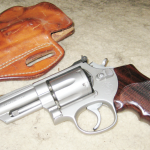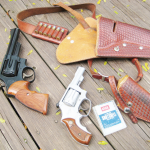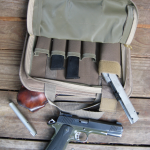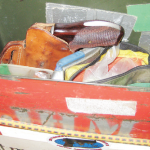by John Markwell
Contributing Editor
- The author’s Model 66 “River Gun” and its DeSantis holster made for the perfect “traveling gun” for use on river trips. Note the modified hammer and cylinder latch as well as the rounding of all the gun’s sharp edges.
- Shown here are the S&W revolvers the author and his wife had in hunting camp with them. The blue gun is a 5-inch Model 29 44 magnum. The silver gun is a Model 317 Airlite in .22LR. Holsters are by ElPaso Saddlery.
- Part of the ensemble of “traveling guns” taken on the author’s most recent varmint hunting trip. The Kimber Rimfire Target 1911 in .17 Mach2 along with the Iver Johnson .22LR conversion unit and other accessories are nicely contained in the Brownells Rimfire Conversion Case.
- The author’s S&W Model 66 as carried on the Rio. Nestled in the .50-caliber can, the gun was protected from the elements yet was readily available for use.
Like many handgunners, there was a time in my youthful years when deciding which handgun to take along on a trip was a very simple affair. Your choices are pretty limited when there is only one gun on the list.
Before I was married, my only handgun was a .22 Long Rifle Colt Woodsman Match Target pistol with a 6” barrel. The Woodsman was an accurate and reliable companion on all of my adventures for a fair number of years. It was with the Woodsman that I learned to shoot a handgun. I wish I still had that gun. The Colt Woodsman was traded off for a 9mm Browning High Power shortly after I got married in the late ’60s.
I’ve often wondered what possessed me to acquire that first High Power.
Regardless, the Browning pistol became the traveling gun, again by default. I don’t remember the exact chronology of what-was-owned-when during my one-at-a-time handgun days.
I do vividly remember hauling a Smith & Wesson Model 27 .357 Magnum with an 8-3/8 inch barrel into the Bob Marshall wilderness on a week-long backpack trip in the mid ’70s. Toted in a spring-loaded, front-break Bianchi crossdraw holster, this was about as un-handy for bear protection as it can get, especially when carrying a pack.
I know that over time there was a Smith & Wesson K-22 in the mix, as well as a Walther PPKS in .22LR, and a Colt Gold Cup .45ACP, among others.
All accompanied our small but expanding family for security (the 22s sometimes giving a false sense of same) and sport on numerous outdoor adventures.
Packing a handgun along on outings or trips has been a tradition in America since before the Republic was formed.
Whether traveling close to home or far afield, the reasons for having a handgun along when traveling are the same today as they were 200+ years ago.
First and foremost, the handgun can provide protection from predators; both the two- and four-legged varieties.
Secondly, when used with skill, the handgun can be used for foraging or dispatching pests around campsites (where legal). And finally, it is just plain fun to have a handgun along for informal shooting—plinking, if you will.
If there is one thing I learned as my pile of handguns has expanded over the years, it is that there is no perfect “Traveling Gun” for all situations. Different outdoor pursuits can place varying demands on the “Traveling Gun.” When embarking on any outing, a decision must be made as to what tasks the traveling gun may be called upon to perform above and beyond the obvious primary one of providing security for you and yours. This often involves compromising on a gun’s performance of certain tasks or taking multiple guns along.
What follows are some examples of how I have approached this sometimes confusing situation over the years.
Searching for the perfect “river gun.” During the 1980s and ’90s, I helped an outfitter friend, whose business was next to mine, run some wilderness river trips on the Rio Grande in the Big Bend region of Texas. These canoe trips took place in the early spring and late fall on a beautiful stretch of this desert river known as the Lower Canyons.
With a dozen or more clients, we were on the river for 7 or 10 days each trip.
Depending on where we put in, we covered 80 to over 100 river miles per trip. This is extremely isolated and rugged country with no road access to the river except at the two put-ins and the take-out point. Once you begin the trip, you are pretty well committed and any kind of help is a long way off. (And no, cell phones don’t work there) This border country has always had a reputation as a drug and human smuggling corridor. Isolated violence associated with those trades, although not common, does occur in the Big Bend area. Also, this Chihuahua desert country has a pretty good population of rattlesnakes and lesser pests that can be of some concern around riverside camps. Odd acting (possibly rabid) skunks were often encountered at frequently used camping sites. On these trips, I lived out of a large, waterproof rubber duffle bag and a tall 50-caliber ammo can. The duffle contained my “home”; shelter, bed, and extra clothes. Tethered to a canoe thwart, the big 50 caliber can served to protect all the small stuff that needed to stay dry; camera and film, journal, first aid kit, lots of odds and ends and my “river gun.” Over a period of 10 or 12 years I made this trip over a dozen times. After trying assorted calibers in both autos and revolvers during my early trips to the Rio, and finding each wanting in one way or another, my “river gun” finally evolved. It is a purpose-driven piece, capable of handling any problems I might encounter on most any river trip or while traveling to same; it is a revolver.
Above and beyond being suitably powerful for defensive use and being able to launch CCI shot cartridges for snakes, my ideal river gun needed to be pretty much maintenance free. The gun and its holster also had to fit in the space available in my 50-caliber can.
After pressing a series of guns into this role (with varying degrees of satisfaction), I finally settled on a 3-inchbarreled, stainless steel, round butt Smith & Wesson Model 66 two-inch in .357 magnum, as my ideal river gun.
The 3-inch barrel has been Magnaported to help control the recoil of hot .357 magnum loads and it sports a plain black, ramped and serrated front sight that is pinned to the barrel rib.
The rear sight is the standard S&W adjustable with a plain black blade. The 3-inch barrel allows for a full length extractor rod which in turn makes complete case extraction possible. The hammer has been rounded for a snag free profile and the cylinder latch has been de-horned so as to not knock the bark off my thumb. All of the edges on the 66 have been lightly broken, giving the gun that “used bar of soap” feel.
The trigger face is smooth, facilitating good control while shooting double action.
For shooting comfort, recoil control and to enhance concealment if necessary, the round butt of the 66 wears an old set of checkered Fuzzy Farrant custom stocks. The revolver lives in a DeSantis pancake style leather holster. This is essentially a maintenance-free revolver that can handle full house, .357 magnum ammo, .38 Special mid-range loads, and CCI shot loads interchangeably, covering any possible contingency that could be encountered on the Rio. The 66 also served well for security on the road traveling to and from the Big Bend Country. This revolver has logged countless road miles and more than 1,000 river miles over the years. Other than an occasional thorough cleaning to get the inevitable desert sand out of the action (which permeates everything on the river), it has required no maintenance whatsoever. I have yet to come up with a better option for a river gun than this old Model 66. As a comforting companion on the river, or the road, my S&W 66 has proven to be a pretty good “Traveling Gun” for this particular application.
Other outdoor scenarios require a different approach. While my wife and I were living and working in a Wyoming hunting camp in grizzly country, we were faced with a different set of requirements in choosing a traveling gun. Actually we ended up with two handguns which served our needs in and around elk camp. First we took Tanker holster was quick and easy to put on or take off and could be hung up anywhere to be close at hand. There is a six-round spare ammo carrier attached to the harness of the tanker holster and a small fixed blade knife is affixed to its back in a Kydex sheath.
The only modifications made to the Model 29 were the addition of a gold bead front sight, the narrowing and smoothing of the trigger, and the addition of custom Boot Grips by Craig Spegal. The .44 magnum was kept loaded with either Cor-Bon 300-gr.JSP ammo or a pretty hot handload with a 320-gr. LBT cast lead bullet. While the big 44 was constantly at hand around camp, and was always carried when packing in or out with hunters, it, fortunately, never saw any actual use.
Like a first aid kit, the Model 29 was there in case it was needed.
Our second gun, which actually got used quite a bit, was a Smith & Wesson Model 317 Airlite .22 caliber revolver.
This handy 3-inch-barreled revolver was mostly used with .22 LR shot cartridges. For keeping the small vermin in and around the cook tent under control, this revolver was just perfect. We traveled from West Virginia to Wyoming to work at this camp (now Hoback Peak Outfitters) for five or six hunting seasons and spent the better part of the each fall traveling and camping before and after our time in camp. This pair of Smiths proved to be ideal “traveling guns” for our time spent in hunting camp and while exploring in the mountain west.
Much of my present day traveling is often centered around touring historical sites (in both the east and west) with my wife and making an extended annual varmint shooting trip to the West each year. Being retired and living in the heart of the Allegheny Mountains, we also travel a fair bit close to home and spend time at my wife’s mountain cabin. Travel is mostly by truck with a slide-in camper on the back and we normally try to camp in pretty out-of-the-way places; BLM and Forest Service areas being our favorites.
We purposely avoid states like New York, Massachusetts, and Illinois where traveling with firearms can be problematic. My present day traveling guns are still “mission specific” if necessary. Having a few more to choose from keeps the process interesting and entertaining although at times the choice is simpler than one might think.
Unless there is a specific use to be addressed (like bears or pests or hunting) choosing a gun just for traveling usually comes down to just a defensive piece often supplemented by a “plinker” of some sort. And then, at times it can be a bit more complex.
A final example. As this is written, I’m just back from my 2012 summer varmint hunting trip which, over a period of 30-some days covered almost 7,000 miles and took me to the Dakotas, Montana, Wyoming, and Idaho. As well as a few varmint rifles, some “traveling guns” also made the trip. For general and on the road security I took along my current everyday carry gun which is a 9mm Springfield Armory EMP loaded with 147-gr. Federal Hydra-shok ammunition.
Anticipating camping and doing some fishing in western Montana/ Idaho (bear, and now wolf, country) my old faithful 5-inch Smith Model 29 made the trip. The .44 Mag was loaded with some of the above mentioned Cor-Bon ammo when hiking or fishing in the back country.
For carry in the varmint fields, a Kimber Rimfire Target 1911 in 17 Mach2 made the trip. This tiny cartridge in the 1911 pistol is great fun for close range prairie dog and gopher shooting, plus it’s pretty tough on rattlesnakes too. To cover my plinking needs, I took along a .22 Long Rifle Iver Johnson Commander-length conversion unit. This .22 caliber top unit runs perfectly on the Mach2 Kimber 1911 frame and uses the same magazines.
The Kimber 17 Mach2 and the IJ conversion unit travel in the extremely handy Brownells 1911 Auto Rimfire Conversion case. This new case from Brownells has room for a complete 1911 pistol, a conversion unit, extra magazines, a holster and mag pouch, and even a few boxes of ammo. This list may seem like overkill to some but for my purposes, on this particular extended trip, the above guns filled their individual roles well and were used often.
Americans are much luckier than many folks in other countries who have lost their right to possess and use firearms, specifically handguns in many cases. Whether you have one handgun or a bunch to choose from, try taking a “traveling gun” (or two or so) on your next adventure. Even if not totally suitable to the tasks at hand, the “traveling gun” can provide a sense of security for you and yours as well as add another dimension to your recreational activities.
As always, check state and local laws on possession and use of firearms before setting out with your choice of “traveling gun.” As for me, I’m always re-evaluating my “traveling guns” and looking forward to taking one or more of them on future outdoor adventures. I wish you safe and pleasant outings with your choice of “traveling guns.”







